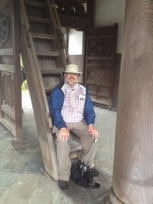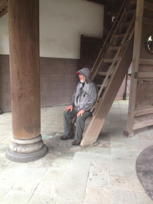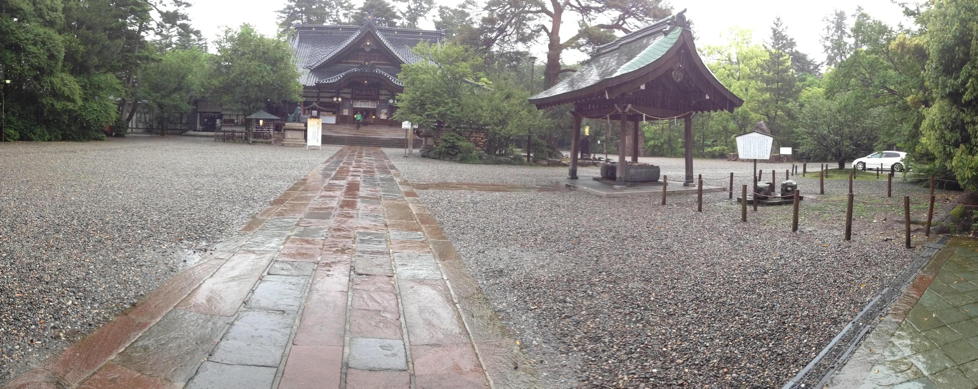
|
|
The Oyama
Jinja shrine, last stop of the day before dinner
(larger version). Picture taken from the gate, where Mike, Mark, and I sheltered while the others took in the shrine. |
Monday, 26 May: a rainy day without many pictures
An interesting day, but on the whole I think that all of us wish that it had been different. Because there are so few pictures from today, I’ll be quoting mostly from my journal.
«Breakfast in the hotel, sitting at table, much more comfortable than the day before. Vegetables and soft tofu in a broth were soon boiling over a little alcohol burner. Otherwise, familiar Japanese fare, but including nattō, a sticky and mucoid fermented bean that didn’t have that much of a different flavor from the other red beans we’ve been eating.
«As we sat talking bout the various museums we were planning to visit, the desk clerk came over and told us that as it was Monday, the museums would be closed. A disaster! It was principally the museums here that made Mike choose to schedule Kanazawa for our trip. It turned out that at least one museum, the Traditional Crafts Museum, would be open today, and the D.T. Suzuki Museum seemed to be open as well. To get to this last, we’d have to walk by the 21st Century Museum of Modern Art, and as we did so, we saw people inside. It turns out that this museum has a public area distinct from the exhibition areas, and this is open year round. So we went in and got out of the rain, and walked about.»

The outer passage at the Modern
Art Museum
(big image,
small).
«But the rain! It was constant, or at least broke hardly at all, and it was frequently heavy. We were already wet when we left the Modern Art, and we walked, walked, walked, in the rain, rain, rain. We thought we were at the place where the map told us the Suzuki Museum was, but the road petered out to nothing, and when Mike asked a passing elderly gentleman, it turned out that the Suzuki was more than a few blocks away. Mark was handling the map, and apparently got us turned around, and we walked, walked, walked. Cindy spotted a street sign for the Suzuki, and soon we were seeing these more and more frequently. We were there! CLOSED. But again there was a publicly-available walking path that we could take, to make us feel that we done Daisetz Teitaro some honor.
«Finally we got to an open museum, the Museum of Traditional Crafts, and spent a good while there, then took a bus, within which an [even more] elderly gentleman tried to engage me in conversation, which I was open to, but the language problem was rather great. [Nobody could figure out why he chose me, of all our group, to try to talk with, but afterwards, I thought maybe that first, I was clearly the nearest his age of all of us, and second, I was the only one wearing a sports jacket, while the others were more appropriately dressed for the weather. And it turned out that he had been a teacher, and was inordinately pleased when I told him that I was a retired teacher too.]
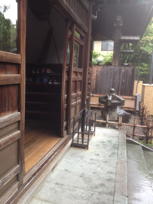
«Off the bus, we found a little restaurant where we had a pleasant lunch and then walked to the so-called Ninja Temple, which actually was the house [no, it was both temple and stronghold, more exactly] of a lord who resisted the Shogun and made [the temple] a treasure of trapdoors, deadfalls, hidden stairways, and secret passages.»
On reflection, Mark and I have agreed that this place was one of the most interesting that we visited. I had not been at all enthusiastic about the idea of going to see it, but it would have been a real loss to miss it. Since it was a genuine working temple, we were not allowed to take pictures. So all we have is a small number of exteriors.

|
|
Picture taken with the panorama function of the iPhone. The “Ninja
Temple” again. Panorama shots have a way of messing
up people in motion. Cindy’s left arm seems weirdly shrunken, and the man in the yellow slicker may have three legs (bigger image). |
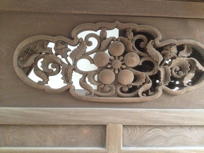
Walking there in the rain, we stopped at one more shrine. I think that by this time, the three old guys had become shrined out, and we waited in the gate-structure of the Oyama-Jinja while Mason and Cindy did the Shinto temple proper. The gate building dates only to 1875, and has some very interesting carvings. I noticed the one to the left, but Mark has some that are rather better on his page.
From there we walked back, and as we did so, Cindy declared that she had had enough walking, and we must therefore have dinner in the hotel. This we did, and it was a fine meal, and from there we all went to our beds and a sound sleep.
